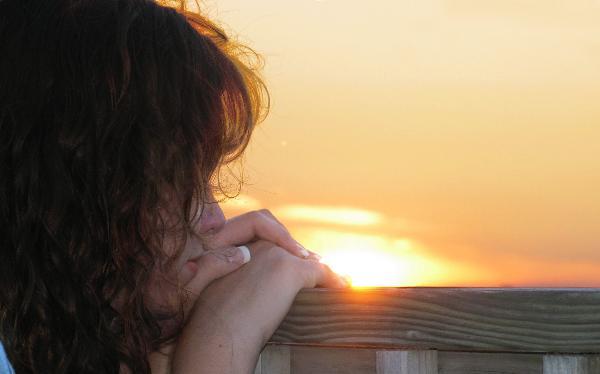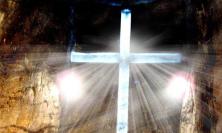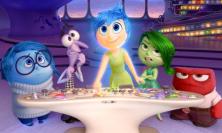
‘A scientist leaning over her computer pondering experimental results; an artist poised, brush in hand, at his canvas; a woman sitting in prayer making the Spiritual Exercises: what do these three have in common?’ Rob Marsh SJ contributes to our celebration of the Year of Faith by exploring what it means to ‘imagine faithfully’, as the scientist, the artist and the woman in prayer are all doing. If imagination is the mediator between idea and reality, how does it relate to faith?
A scientist leaning over her computer pondering experimental results; an artist poised, brush in hand, at his canvas; a woman sitting in prayer making the Spiritual Exercises: what do these three have in common? Whatever else they share they are each engaged in acts of faithful imagination.
The person praying the Spiritual Exercises and the artist painting are clearly involved in imaginative activities; but the scientist? The English language betrays a certain disdain of imagination – imaginary, fantastic, artificial – seeing it as not altogether trustworthy, not completely serious, and not the sort of thing we want messing up our pursuit of objective truth. Yet the scientist is performing a signature imaginative activity: discovering a pattern; seeing the wood for the trees; finding insight. Her imagination glimpses hypotheses that go ‘behind’ and ‘beneath’ her experimental results. However much she has ‘the scientific method’ at hand to test her insight into the patterns of nature, the method works on what her imagination sees emerging tentatively from her data.
‘Seeing’ as a model of imagination has a long history from classical times to the present. In the Hellenistic understanding, the imagination was the way a copy of an object ‘out there’ became re-presented ‘in here’, in the mind.[1] We can only think with the images of things and not things themselves, and the imagination was understood to be the faculty that copied those images from the world of things to make them available for thought. As we know from our experience of photocopiers, copying is a process that always introduces error. The Greeks knew it, too and so they viewed imagination as the chief obstacle to perfect perception and the ideal reasoning that might be built upon it. This very epistemic approach to imagination emphasises its fallibility, even if admitting its unavoidable part in perception and reasoning. Our scientist stares at the tangle of traces before her and sees them not as pixels on a screen but as the birth and death of a Higgs boson – but she might be wrong.[2]
Yet seeing and ‘seeing as’ are not the only ways the imagination has been conceived. Our artist at his canvas is certainly seeing the colour and form before him but he is also making something of it, shaping it, forming paint in patterns of colour and texture. We recognise the creative aspect of imagination, the way it makes something new. I have focused on a painter, but this facet of imagination is present in all art and in all craft, however humble, wherever something is shaped or made by human ingenuity. Alongside the Hellenistic view of imagination, the Hebraic tradition offers an equally ancient understanding that acknowledges the creative power of the imagination, even to the point of fearing it in human hands.
The heart’s imagination in Hebrew shares a root with the word for the potter. God’s work when he forms humanity from the dust is the paradigm case of such imagination. And there is a tradition of recognising that same life-giving power in the human imagination – hence the regulation of image-making in the Hebrew Bible. Rabbinic reflections on the source of good and evil in the world focused on the good and bad imaginations of the human heart. If the Greeks found imagination an epistemic issue, for the Hebrews it was a matter of ethics: how to govern the human capacity to make and create, and save it from the temptation to usurp God’s own creativity.
Christianity has been heir to both of these understandings of imagination from its beginning, not without a certain tension, often centred on the image. Is the image to be trusted? Can it adequately represent God or will it always verge on idolatry? The question recurs in Christian history from the iconoclast controversies of the Eastern Church, to the striving for direct access to God in the Reformation. Perhaps it shows itself today in our liturgical wars. The imagination always occupies an in-between place, whether standing between idea and reality or providing the way for idea to be made into reality. The question of imagination is the question of mediation: whether truth can come to us directly or whether it only comes through a medium, like the paint our artist places on his canvas; whether God can meet us directly or whether we have to find God through the world, natural or created. Where do we look to answer such persistent questions?
The Hellenistic and the Hebraic traditions do not exhaust our resources: we heirs of Modernity are used to considering imagination also as an aesthetic matter, a matter of the beautiful as well as a matter of the true and the good.[3] Understanding the imagination aesthetically uncovers an aspect of imagination that logic and ethics can obscure. Truth and goodness pretend to absoluteness, but beauty is notoriously in the eye of the beholder. The aesthetic imagination has to deal head-on with the role of the human in the emergence of value. Is something beautiful for its inherent qualities or is beauty conferred by the observer? The imagination understood aesthetically is always torn two ways; neither apart will do.
My late friend and mentor, the theologian Alejandro García-Rivera, believed the human imagination is the place where the invisible become visible, that beauty is neither objective nor subjective but happens in between the subject and the object. He saw the fundamental aesthetic act as the ‘lifting up of the lowly’ – the giving of value to what is worthy of value. He defined aesthetics as ‘the study of what moves the human heart’ and saw it as an essentially religious matter.[4] And this brings us to our third person, the one making the Spiritual Exercises.
The traditional language of Ignatian spirituality is significant: one does not pray the Spiritual Exercises or undergo them; one makes them. This is a month long aesthetic act of imagination, with seeing and forming combined into something else: an act of presence. What do I mean? The one making the Exercises takes Ignatius’s terse ‘points’ for prayer and imagines a little world based upon them. It may be a gospel story under contemplation but the one imagining shapes a scene out of fragments of memory and invention, and attempts for a time to live in it alongside other characters and with Jesus himself. They ‘make’ and then they ‘see’ what it is like to be there, to interact, to breathe the gospel. But of course the making is full of seeing, and vice versa, and out of their interplay something may come alive, may become present. The part of each Exercise that Ignatius called the colloquy makes it clear. The one making the Exercises is invited to get into conversation ‘friend to friend’ with Jesus, a real dialogue with an imagined presence. And, if they are at all drawn in, they find themselves moved in the heart. Desire is stirred up, maybe fear too. Because that is the nature of aesthetics as the study of what moves the human heart: when we imagine and allow ourselves to be moved, we find ourselves moved in different directions.
Imagination always poses a choice, a discrimination between options and a commitment to one and not another. The scientist takes what she sees in her data and chooses a theory, chooses another experiment, chooses to make something new to the world. The artist puts paint on canvas and sees the result and chooses his next stroke. We take this so much for granted that perhaps the choosing is overlooked. But in the Exercises, Ignatius makes the act of choice explicit and gives rules of thumb for making a ‘good’ choice, for telling real presence from fake – the activity we have come to call ‘discernment of spirits’. When I pray with my imagination I find two impulses activated by what I encounter. For example, I might hear Jesus invite me to walk with him and feel both a desire to respond and a worry that he might ask me an awkward question. Which of these two ‘movements’ should I receive and which should I reject? Which ought I to encourage and which should I set aside? This is the art of discernment. Arguably it is what the Spiritual Exercises are designed to encourage and calibrate.
Whenever the imagination poses a choice, faith is implicated – and not just when the subject matter is explicitly religious as in the Exercises. Something akin to discernment is going on within our artist and our scientist too, some faith is being deepened or not. I do not mean this in the trivial sense that religious pundits sometimes use when they accuse scientists of relying on their own version of faith: this goes deeper. Whenever the imagination gets involved – which is everywhere – we are faced with the question of quality, of value. Where does value come from? We are inclined to be split between a scientific imagination that systematically omits value from the world – despite the pattern-perceiving acts upon which science is built – and the imagination of the humanities that conjures a profusion of possible culture-relative values. But the naturally religious imagination – which has rather been marginalised for the last few hundred years – insists that value is to be discovered in the world in a way that moves the human heart. Or, perhaps better, between the world and the human heart when they are engaged together in imagination. The religious imagination insists that imagination does not just run wild but that imagination is always faithful or unfaithful to something real, and that we can register the difference in how it moves the heart.
I said above ‘always’. The work of anthropologist Lawrence Sullivan is instructive here.[5] He sees myth as the imagination reflecting on itself and its own origins. One of the ubiquitous classes of myth is the origin story – how we and our way of life get to be here – and the typical pattern is a sort of twofold creation. The ‘first’ creation story tells how a primordial time came to be, a strange, sacred time when the proto-human and the divine lived together without any kind of mediation – a time before imagination. It is not a time we recognise, with no trace of our culture and our ways of life, but a chaotic realm of oddness – blessing and terror – that comes to an end with a second creation story that tells how human culture began. The common pattern is that culture – the human imagination – plays a dual role. It both sets that sacred primordium at a safe distance, allowing life to be lived, and it simultaneously mediates the sacred to us in a manageable form. In this sense all human culture is naturally religious, science and technology as much as art or worship. The imagination is an inescapable work of faith, and the world – of science and of art – is full of presences, real or fake.
It is the religious imagination that allows the work of imagining to be faithful, gives it a method, and saves it from fantasy. The art of discernment is at once humble – it does not pretend to the kind of rigour that science represents – and potentially very powerful. We can lose sight of that power because it is usually encountered in the intensely personal context of prayer. Who else cares if I can use discernment to draw closer to God or choose a path in life?! But what if we took seriously the communal and cosmic nature of the world of imagination? Then we might see its promise and its challenge.
Let me hint at an example. Take a moment to recall a place that has been sacred to you, that somehow makes present the significant, the divine, maybe even the uncanny. Sacred is the best word. Use your memory and imagination to recall the sensory details of that place and the feel of being there. Ask your imagination if the ?spirit? of that place has a desire – for you, for others, or in some other way. Give it a try.
Everyone seems able to do at least the first parts of that exercise. We all seem to know at least one sacred space, whether in the natural world or the human sphere, and we can all feel its quality and our response to it. We can begin to discern it. And most of us – if we give the experience the benefit of the doubt – can give that sacred space a voice, hear its desire.
What if we applied the faithful imagination next time we had to site a wind farm or build a nuclear power plant?
Rob Marsh SJ works at Loyola Hall Jesuit Spirituality Centre, Rainhill.
[1] Richard Kearney, The Wake of Imagination: toward a postmodern culture (University of Minnesota Press, 1988). I have used and much abbreviated his account of the Hellenistic and Hebraic imaginations.
[2] The seminal account of ‘seeing as’ in science is found in Norwood Russell Hanson, Patterns of Discovery: An Inquiry into the Conceptual Foundations of Science (Cambridge University Press, 1958).
[3] Susanne K. Langer, Feeling and Form (Routledge & Kegan Paul, 1979).
[4] Alejandro García-Rivera, The Community of the Beautiful: a theological aesthetics (Liturgical Press, 1999).
[5] Lawrence E. Sullivan, Icanchu’s Drum: an orientation to meaning in South American religions (Macmillan: New York, 1988).
More articles for the Year of Faith:
![]() ‘Faith in the Gospels’ by Peter Edmonds SJ
‘Faith in the Gospels’ by Peter Edmonds SJ
![]() ‘A Contemplative Space:
‘A Contemplative Space:
Pondering God’s mystery across faiths ’ by Michael Barnes SJ
![]() ‘Faith in the Old Testament’ by Nicholas King SJ
‘Faith in the Old Testament’ by Nicholas King SJ
![]() Loyola Hall
Loyola Hall





